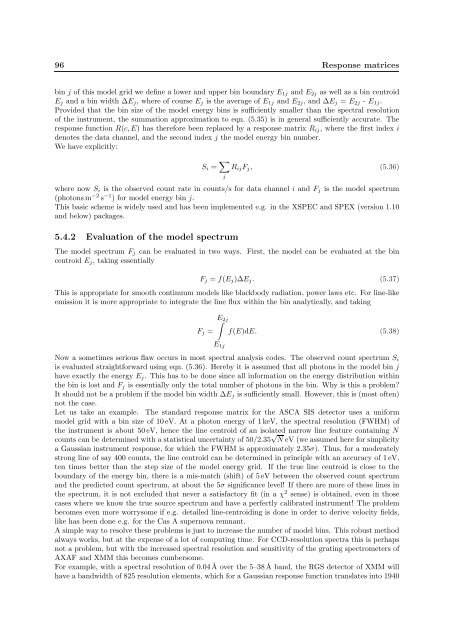SPEX User's Manual - SRON
SPEX User's Manual - SRON
SPEX User's Manual - SRON
Create successful ePaper yourself
Turn your PDF publications into a flip-book with our unique Google optimized e-Paper software.
96 Response matrices<br />
bin j of this model grid we define a lower and upper bin boundary E 1j and E 2j as well as a bin centroid<br />
E j and a bin width ∆E j , where of course E j is the average of E 1j and E 2j , and ∆E j = E 2j - E 1j .<br />
Provided that the bin size of the model energy bins is sufficiently smaller than the spectral resolution<br />
of the instrument, the summation approximation to eqn. (5.35) is in general sufficiently accurate. The<br />
response function R(c, E) has therefore been replaced by a response matrix R ij , where the first index i<br />
denotes the data channel, and the second index j the model energy bin number.<br />
We have explicitly:<br />
S i = ∑ j<br />
R ij F j , (5.36)<br />
where now S i is the observed count rate in counts/s for data channel i and F j is the model spectrum<br />
(photons m −2 s −1 ) for model energy bin j.<br />
This basic scheme is widely used and has been implemented e.g. in the XSPEC and <strong>SPEX</strong> (version 1.10<br />
and below) packages.<br />
5.4.2 Evaluation of the model spectrum<br />
The model spectrum F j can be evaluated in two ways. First, the model can be evaluated at the bin<br />
centroid E j , taking essentially<br />
F j = f(E j )∆E j . (5.37)<br />
This is appropriate for smooth continuum models like blackbody radiation, power laws etc. For line-like<br />
emission it is more appropriate to integrate the line flux within the bin analytically, and taking<br />
F j =<br />
E 2j ∫<br />
E 1j<br />
f(E)dE. (5.38)<br />
Now a sometimes serious flaw occurs in most spectral analysis codes. The observed count spectrum S i<br />
is evaluated straightforward using eqn. (5.36). Hereby it is assumed that all photons in the model bin j<br />
have exactly the energy E j . This has to be done since all information on the energy distribution within<br />
the bin is lost and F j is essentially only the total number of photons in the bin. Why is this a problem?<br />
It should not be a problem if the model bin width ∆E j is sufficiently small. However, this is (most often)<br />
not the case.<br />
Let us take an example. The standard response matrix for the ASCA SIS detector uses a uniform<br />
model grid with a bin size of 10eV. At a photon energy of 1keV, the spectral resolution (FWHM) of<br />
the instrument is about 50eV, hence the line centroid of an isolated narrow line feature containing N<br />
counts can be determined with a statistical uncertainty of 50/2.35 √ N eV (we assumed here for simplicity<br />
a Gaussian instrument response, for which the FWHM is approximately 2.35σ). Thus, for a moderately<br />
strong line of say 400 counts, the line centroid can be determined in principle with an accuracy of 1eV,<br />
ten times better than the step size of the model energy grid. If the true line centroid is close to the<br />
boundary of the energy bin, there is a mis-match (shift) of 5eV between the observed count spectrum<br />
and the predicted count spectrum, at about the 5σ significance level! If there are more of these lines in<br />
the spectrum, it is not excluded that never a satisfactory fit (in a χ 2 sense) is obtained, even in those<br />
cases where we know the true source spectrum and have a perfectly calibrated instrument! The problem<br />
becomes even more worrysome if e.g. detailed line-centroiding is done in order to derive velocity fields,<br />
like has been done e.g. for the Cas A supernova remnant.<br />
A simple way to resolve these problems is just to increase the number of model bins. This robust method<br />
always works, but at the expense of a lot of computing time. For CCD-resolution spectra this is perhaps<br />
not a problem, but with the increased spectral resolution and sensitivity of the grating spectrometers of<br />
AXAF and XMM this becomes cumbersome.<br />
For example, with a spectral resolution of 0.04Å over the 5–38Å band, the RGS detector of XMM will<br />
have a bandwidth of 825 resolution elements, which for a Gaussian response function translates into 1940

















